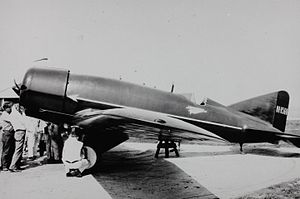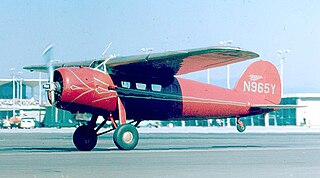
The Lockheed Vega is an American five- to seven-seat high-wing monoplane airliner built by the Lockheed Corporation starting in 1927. It became famous for its use by a number of record-breaking pilots who were attracted to its high speed and long range. Amelia Earhart became the first woman to fly solo across the Atlantic Ocean in one, and Wiley Post used his to prove the existence of the jet stream after flying around the world twice.

The Lockheed Model 9 Orion is a single-engined passenger aircraft built in 1931 for commercial airlines. It was faster than any American military aircraft of that time. Designed by Richard A. von Hake, it was the last wood aircraft produced by the Lockheed Aircraft Corporation.
The Lockheed Model 10 Electra is an American twin-engined, all-metal monoplane airliner developed by the Lockheed Aircraft Corporation, which was produced primarily in the 1930s to compete with the Boeing 247 and Douglas DC-2. The type gained considerable fame as one was flown by Amelia Earhart and Fred Noonan on their ill-fated around-the-world expedition in 1937.

The Douglas XTB2D Skypirate was a torpedo bomber intended for service with the United States Navy's Midway- and Essex-class aircraft carriers; it was too large for earlier decks. Two prototypes were completed, but the dedicated torpedo bomber was becoming an outdated concept, and with the end of World War II, the type was deemed unnecessary and cancelled.

The Pratt & Whitney R-1340 Wasp is an aircraft engine of the reciprocating type that was widely used in American aircraft from the 1920s onward. It was the Pratt & Whitney aircraft company's first engine, and the first of the famed Wasp series. It was a single-row, nine-cylinder, air-cooled, radial design, and displaced 1,344 cubic inches (22 L); bore and stroke were both 5.75 in (146 mm). A total of 34,966 engines were produced.

The Douglas Dolphin is an American amphibious flying boat. While only 58 were built, they served a wide variety of roles including private air yacht, airliner, military transport, and search and rescue.

The Howard DGA-8, DGA-9, DGA-11, and DGA-12 were a family of four-place, single-engine, high-wing light monoplanes built by the Howard Aircraft Corporation, Chicago, Illinois from 1936.

The Lockheed R6V Constitution was a large, propeller-driven, double-decker transport aircraft developed in the 1940s by Lockheed as a long-range, high-capacity transport and airliner for the U.S. Navy and Pan American Airways. Only two of the aircraft were ever built, both prototypes. Although these two planes went into service with the Navy, the Constitution design ultimately proved underpowered and too large for practical airline use at the time. Although the Martin JRM Mars flying boat had a slightly longer wingspan, the Constitution remains the largest fixed-wing aircraft type ever operated by the U.S. Navy.
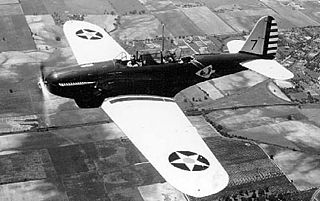
The Consolidated P-30 (PB-2) was a 1930s United States two-seat fighter aircraft. An attack version called the A-11 was also built, along with 2 Y1P-25 prototypes and YP-27, Y1P-28, and XP-33 proposals. The P-30 is significant for being the first fighter in United States Army Air Corps service to have retractable landing gear, an enclosed and heated cockpit for the pilot, and an exhaust-driven turbo-supercharger for altitude operation.
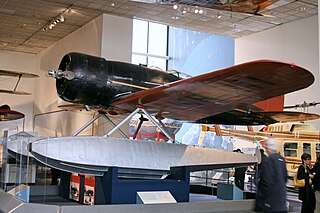
The Lockheed Model 8 Sirius is a single-engined, propeller-driven monoplane designed and built by Jack Northrop and Gerard Vultee while they were engineers at Lockheed in 1929, at the request of Charles Lindbergh. Two versions of the same basic design were built for the United States Air Force, one made largely of wood with a fixed landing gear, and one with a metal skin and retractable landing gear, designated Y1C-25 and Y1C-23, respectively. Its basic role was intended to be as a utility transport.

The Lockheed Air Express was the second aircraft design created by the Lockheed Aircraft Company after its founding in 1927; the type first flew in April 1928.

The Lockheed Altair was a single-engined sport aircraft produced by Lockheed Aircraft Limited in the 1930s. It was a development of the Lockheed Sirius with a retractable undercarriage, and was the first Lockheed aircraft and one of the first aircraft designs with a fully retractable undercarriage.

The PWS-24 was a Polish single-engine passenger aircraft for 4 passengers, built in PWS factory, used from 1933 to 1936 by LOT Polish Airlines. In spite of its limited capacity, it was the only series-built airliner of domestic design ever used by the LOT.

The Fairchild F-11 Husky was a Canadian bush plane designed and manufactured in the post-Second World War era. Despite a promising design, a lack of a suitable powerplant hurt performance, and stiff competition from the de Havilland Beaver and de Havilland Otter designs meant the type never gained a solid foothold in the marketplace.

The Douglas O-2 was a 1920s American observation aircraft built by the Douglas Aircraft Company, powered by the Liberty engine of WW1 fame, with some later variants using other engines. It was developed into several versions, with 879 being produced in total. It was used in combat by the Chinese Air Force in the 1930s and also was the basis for a successful mailplane version.
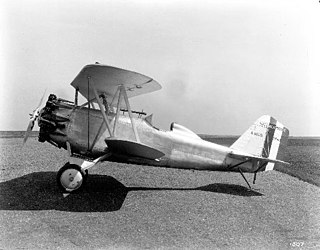
The Hall XFH was an American fighter aircraft built by the Hall Aluminum Company. It was the first fighter with a semi-monocoque metal fuselage.

The Lockheed XC-35 is a twin-engine, experimental pressurized airplane. It was the second American aircraft to feature cabin pressurization. It was initially described as a "supercharged cabins" by the Army. The XC-35 was a development of the Lockheed Model 10 Electra that was designed to meet a 1935 request by the United States Army Air Corps for an aircraft with a pressurized cabin.

The Douglas XP3D was a prototype American patrol flying boat of the 1930s. A twin-engined high-winged monoplane, the P3D was produced by the Douglas Aircraft Company to equip the US Navy's Patrol squadrons, but despite meeting the Navy's requirements, the rival Consolidated PBY was preferred owing to a lower price.

The Lockheed Model 34 Big Dipper was an American two-seat monoplane, designed and built by Lockheed at Burbank for research into the company's potential entry into the civil lightplane and military light utility aircraft market. Only one was built, and following its loss in an accident the program was abandoned.
The Lockheed Model 44 Excalibur was a proposed American airliner designed by Lockheed. The Model 44 was the first four-engined design from the company, a low-wing monoplane with a retractable tricycle landing gear. Originally fitted with twin fins, the design ended up with three fins. It was to be powered by four 1,200 hp (890 kW) Pratt & Whitney Twin Wasp radial engines. Pan American Airways was close to ordering the Excalibur when Lockheed abandoned the project to devote its resources to developing the Model 49 Constellation that had been ordered by Trans World Airlines.
